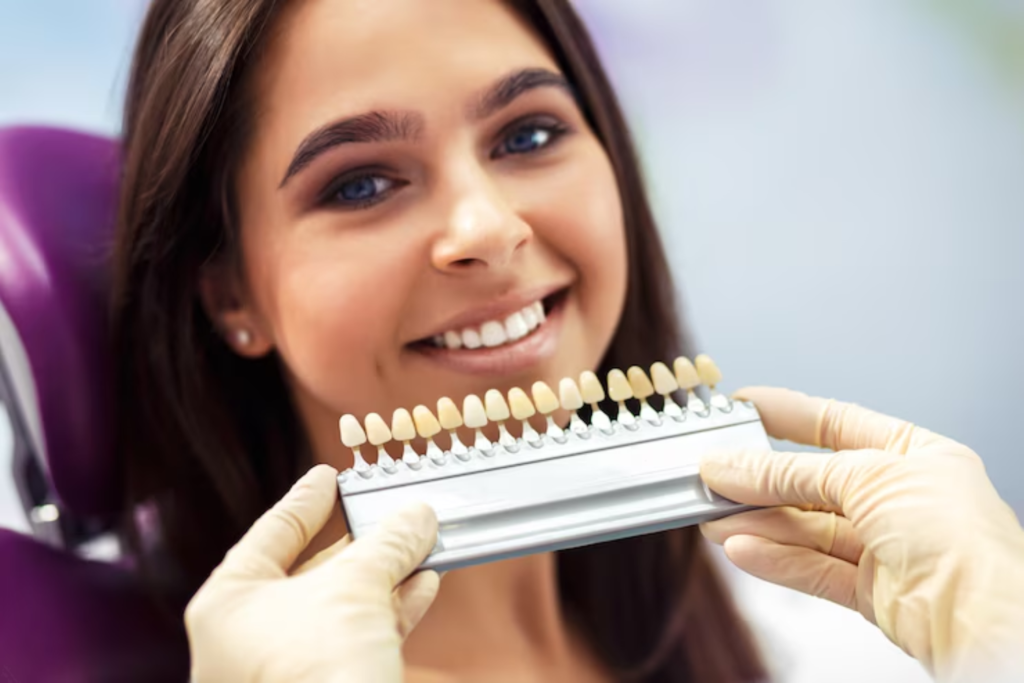Porcelain veneers have become a popular choice for enhancing smiles, offering a durable and natural-looking solution for various cosmetic dental concerns. Simultaneously, teeth whitening remains one of the most sought-after treatments for achieving a brighter, more radiant smile. However, when it comes to maintaining the color and appearance of porcelain veneers, many individuals wonder about the safety of using whitening strips.
Understanding the compatibility of whitening strips with porcelain veneers is essential for those seeking to maintain their bright, beautiful smiles. In this blog, we’ll delve into the intricacies of porcelain veneers and the mechanism of whitening strips, exploring whether they are a safe option for veneer wearers. By gaining insights into the potential risks and alternative whitening methods, individuals can make informed decisions about their dental care and ensure the longevity and aesthetic appeal of their porcelain veneers.
Understanding Porcelain Veneers
These thin shells, custom-made from medical-grade ceramic, are bonded to the front surface of teeth to enhance their appearance. They effectively conceal imperfections like discoloration, chips, or gaps.

Benefits of Porcelain Veneers
Porcelain veneers offer several advantages, including natural aesthetics, durability, and stain resistance. They provide a long-lasting solution for achieving a flawless smile.
How Whitening Strips Work?
Whitening strips typically contain hydrogen peroxide or carbamide peroxide, which penetrates tooth enamel to break down stains. This chemical reaction lightens the color of the teeth.
Effectiveness on Natural Teeth
Whitening strips are generally effective for natural teeth, gradually lifting surface stains to reveal a brighter smile. However, results may vary depending on factors like the severity of discoloration and adherence to usage instructions.
Potential Risks of Using Whitening Strips on Veneers
While whitening strips are effective for natural teeth, using them on porcelain veneers may pose certain risks and limitations due to the unique properties of veneers:
- Ineffectiveness: Porcelain veneers are resistant to stains and do not respond to bleaching agents in the same way as natural teeth. As a result, whitening strips may not effectively lighten the shade of veneers.
- Uneven Results: Attempting to whiten only the veneers with whitening strips while leaving the natural teeth untreated can lead to uneven coloration, creating a mismatched appearance.
- Damage to Veneers: The abrasive nature of some whitening strips may cause damage to the surface of porcelain veneers, leading to roughness or degradation of the veneer material.
- Alteration of Veneer Shade: If whitening strips do have an effect on veneers, they may alter the shade of the veneers unpredictably, resulting in an undesirable color outcome.
Alternative Teeth Whitening Options for Veneers
While whitening strips may not be suitable for porcelain veneers, there are alternative teeth whitening methods specifically designed to address the unique characteristics of veneers:
- Professional Whitening Treatments: Dentists can perform in-office whitening treatments that utilize stronger bleaching agents and specialized techniques to effectively whiten both natural teeth and veneers without causing damage.
- Customized Take-Home Kits: Dentists may provide custom-fitted whitening trays and professional-grade whitening gel for patients to use at home. These kits ensure even application and safe whitening results for both natural teeth and veneers.
- Microabrasion: This minimally invasive procedure involves removing surface stains and discoloration from veneers using a gentle abrasive technique, restoring their natural luster without compromising the integrity of the veneer material.
- Veneer Replacement: In cases where veneers have become severely discolored or damaged, replacing the veneers with new ones in the desired shade can effectively restore a bright, uniform smile.
Tips for Maintaining Veneer Color and Integrity
Preserving the color and integrity of porcelain veneers is essential for prolonging their lifespan and maintaining a radiant smile. Here are some expert tips to help you keep your veneers looking their best:
- Practice Good Oral Hygiene: Brush your teeth at least twice a day and floss daily to remove plaque and prevent staining around the edges of your veneers.
- Use Non-Abrasive Toothpaste: Choose a non-abrasive toothpaste recommended by your dentist to avoid scratching or dulling the surface of your veneers.
- Avoid Staining Foods and Beverages: Minimize consumption of dark-colored foods and beverages like coffee, tea, red wine, and berries, as they can stain both natural teeth and veneers.
- Quit Smoking: Smoking can cause veneers to become discolored over time. Quitting smoking not only improves your overall health but also helps preserve the appearance of your veneers.
- Wear a Mouthguard: If you grind or clench your teeth at night, wearing a custom-fitted mouthguard can protect your veneers from damage and prevent premature wear.
- Attend Regular Dental Check-Ups: Visit your dentist for routine check-ups and cleanings to monitor the condition of your veneers and address any issues early on.
While whitening strips can effectively brighten natural teeth, they may not be suitable for porcelain veneers and could potentially cause damage. It’s crucial to consult with your dentist before attempting any whitening treatments on veneers. By understanding the risks and exploring alternative whitening options, you can maintain the integrity and appearance of your veneers for years to come.




